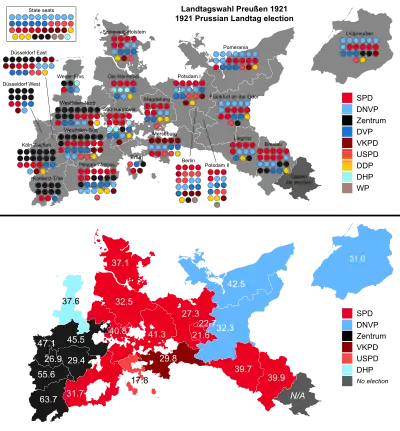1921 Prussian state election
State elections were held in the Free State of Prussia on 20 February 1921 to elect 406 of the 428 members of the Landtag of Prussia.[1] The governing coalition of the Social Democratic Party, Centre Party, and German Democratic Party suffered major losses, losing one-third of its collective voteshare from 1919, but retained a narrow majority. The right-liberal German People's Party (DVP) and reactionary nationalist German National People's Party (DNVP) made the largest gains, with the DNVP becoming the second largest party by voteshare. The Communist Party of Germany contested its first Prussian election, winning 31 seats.
| |||||||||||||||||||||||||||||||||||||||||||||||||||
406 of the 428 seats in the Landtag of Prussia 215 seats needed for a majority | |||||||||||||||||||||||||||||||||||||||||||||||||||
|---|---|---|---|---|---|---|---|---|---|---|---|---|---|---|---|---|---|---|---|---|---|---|---|---|---|---|---|---|---|---|---|---|---|---|---|---|---|---|---|---|---|---|---|---|---|---|---|---|---|---|---|
| Turnout | 77.40% ( | ||||||||||||||||||||||||||||||||||||||||||||||||||
This lists parties that won seats. See the complete results below. | |||||||||||||||||||||||||||||||||||||||||||||||||||
 Top: results by constituency. Bottom: winning party in each constituency. | |||||||||||||||||||||||||||||||||||||||||||||||||||
| |||||||||||||||||||||||||||||||||||||||||||||||||||
No election was held on the constituency of Oppeln due to the Upper Silesia plebiscite, which was held one month after the state elections. The delegation of 22 deputies which had been elected in Oppeln in 1919 continued in office until a 1922 by-election.[2] The discrepancy between these results meant that the Centre Party held more seats in the Landtag than the DNVP after the 1921 election, despite winning fewer votes.
Results
 | ||||||
| Party | Votes | % | Swing | Seats | +/– | |
|---|---|---|---|---|---|---|
| Social Democratic Party (SPD) | 4,295,305 | 26.26 | –10.12 | 114 | –31 | |
| German National People's Party (DNVP) | 2,957,784 | 18.08 | +6.86 | 75 | +27 | |
| Centre Party (Zentrum) | 2,819,989 | 17.24 | –4.98 | 81 | –12 | |
| German People's Party (DVP) | 2,319,281 | 14.18 | +8.49 | 58 | +35 | |
| United Communist Party of Germany (VKPD) | 1,211,749 | 7.41 | New | 31[lower-alpha 1] | New | |
| Independent Social Democratic Party (USPD) | 1,076,498 | 6.58 | –0.84 | 28 | +4 | |
| German Democratic Party (DDP) German Democratic Party (DDP) Landbund |
1,013,239 976,032 37,207 |
6.19 5.97 0.23 |
–10.01 –10.23 New |
26 26 0 |
–39 –39 New | |
| German-Hanoverian Party and Schleswig-Holstein State Party German-Hanoverian Party (DHP) Schleswig-Holstein State Party (SHLP) United Lower Saxon State Party Landeskultur |
438,548 410,312 27,907 227 102 |
2.68 2.51 0.17 0.00 0.00 |
+2.19 +2.02 –0.19 New New |
11 11 0 0 0 |
+8 +9 –1 New New | |
| Economic Party of the German Middle Classes (WP) | 192,780 | 1.18 | New | 4 | New | |
| Christian People's Party (CVP) | 14,140 | 0.09 | New | 0 | New | |
| Polish Party | 12,081 | 0.07 | New | 0 | New | |
| Schleswiger Association | 4,720 | 0.03 | New | 0 | New | |
| Christian Social People's Party | 982 | 0.01 | New | 0 | New | |
| Factionless Party Factionless Party List of Merchants and Wandering Tradesmen |
934 906 28 |
0.01 0.01 0.00 |
New New New |
0 0 0 |
New New New | |
| Non-partisan | 54 | 0.00 | New | 0 | New | |
| Invalid/blank votes | 212,987 | 1.29 | – | – | – | |
| Total | 16,357,755 | 100 | – | 428 | +27 | |
| Registered voters/turnout | 21,410,148 | 77.40 | +2.61 | – | – | |
| Gonschior.de | ||||||
No election took place in constituency #9 (Oppeln); for this purpose, members of this constituency elected in the 1919 election retained their seats.
Results by constituency
| Constituency | SPD | DNVP | Z | DVP | VKPD | USPD | DDP | DHP | WP |
|---|---|---|---|---|---|---|---|---|---|
| 1. East Prussia | 24.0 | 31.0 | 9.6 | 14.7 | 7.0 | 5.7 | 5.7 | – | 1.0 |
| 2. Berlin | 22.7 | 17.4 | 3.9 | 12.5 | 11.6 | 20.3 | 6.8 | – | 4.8 |
| 3. Potsdam II | 21.6 | 20.4 | 3.0 | 19.8 | 7.2 | 13.3 | 9.6 | – | 5.1 |
| 4. Potsdam I | 27.3 | 23.8 | 2.0 | 16.3 | 8.3 | 12.4 | 6.3 | – | 3.6 |
| 5. Frankfurt an der Oder | 31.9 | 32.3 | 6.1 | 13.0 | 2.8 | 6.2 | 6.5 | – | 1.3 |
| 6. Pomerania | 29.4 | 42.5 | 0.7 | 14.1 | 3.3 | 4.7 | 3.3 | – | 2.1 |
| 7. Breslau | 39.9 | 21.5 | 19.6 | 8.4 | 2.5 | 0.9 | 5.6 | – | 1.6 |
| 8. Liegnitz | 39.7 | 22.8 | 8.8 | 11.8 | 2.6 | 1.9 | 9.4 | – | 3.0 |
| 9. Oppeln | [lower-alpha 2] | ||||||||
| 10. Magdeburg | 41.3 | 18.1 | 1.8 | 15.5 | 3.9 | 7.6 | 11.4 | – | 0.4 |
| 11. Merseburg | 10.6 | 22.9 | 1.2 | 14.4 | 29.8 | 11.3 | 9.9 | – | – |
| 12. Erfurt | 11.0 | 11.6 | 14.3 | 14.3 | 11.1 | 17.8 | 6.9 | – | – |
| 13. Schleswig-Holstein | 37.1 | 20.9 | 0.8 | 18.2 | 6.0 | 3.2 | 8.8 | – | – |
| 14. Weser-Ems | 19.1 | 8.5 | [lower-alpha 3] | 17.8 | 2.4 | 5.3 | 9.2 | 37.6 | – |
| 15. Hanover East | 32.5 | 9.6 | 14.4 | 3.8 | 4.1 | 4.6 | 31.1 | – | |
| 16. Hanover South | 40.8 | 7.7 | 18.7 | 3.5 | 2.1 | 4.6 | 22.7 | – | |
| 17. Westphalia North | 22.2 | 10.2 | 45.5 | 10.6 | 5.5 | 2.6 | 3.4 | – | – |
| 18. Westphalia South | 25.0 | 8.1 | 29.4 | 15.6 | 9.5 | 7.3 | 5.1 | – | – |
| 19. Hesse-Nassau | 31.7 | 15.9 | 17.8 | 16.6 | 4.2 | 4.2 | 8.7 | – | 0.8 |
| 20. Köln-Aachen | 19.4 | 5.8 | 55.6 | 9.2 | 5.4 | 1.0 | 3.6 | – | – |
| 21. Koblenz-Trier | 11.5 | 5.5 | 63.7 | 11.2 | 2.3 | 0.5 | 2.8 | – | – |
| 22. Düsseldorf East | 14.5 | 14.1 | 26.9 | 14.1 | 16.6 | 9.2 | 4.7 | – | – |
| 23. Düsseldorf West | 14.3 | 8.0 | 47.1 | 13.5 | 10.0 | 3.8 | 3.2 | – | – |
1922 Oppeln by-election
| Party | Votes | % | Seats[lower-alpha 4] | +/–[lower-alpha 4] | |
|---|---|---|---|---|---|
| Centre Party (Zentrum) | 207,503 | 38.11 | 76 | –5 | |
| Social Democratic Party (SPD) | 80,861 | 14.85 | 109 | –5 | |
| German National People's Party (DNVP) | 79,312 | 14.57 | 76 | +1 | |
| Polish Party | 51,638 | 9.48 | 2 | +2 | |
| German People's Party (DVP) | 42,329 | 7.77 | 59 | +1 | |
| United Communist Party of Germany (VKPD) | 41,597 | 7.64 | 31 | 0 | |
| German Social Party (DSP) | 22,981 | 4.22 | 0 | New | |
| German Democratic Party (DDP) | 15,152 | 2.78 | 26 | 0 | |
| Independent Social Democratic Party (USPD) | 1,188 | 0.22 | 27 | –1 | |
| Economic Party (WP) | 915 | 0.17 | 4 | 0 | |
| German-Hanoverian Party and Schleswig-Holstein State Party German-Hanoverian Party (DHP) Schleswig-Holstein State Party (SHLP) |
532 401 131 |
0.10 0.07 0.02 |
11 11 0 |
0 0 0 | |
| Upper Silesian Catholic People's Party | 246 | 0.05 | 0 | New | |
| Schleswiger Association | 134 | 0.02 | 0 | 0 | |
| Christian People's Party (CVP) | 36 | 0.01 | 0 | 0 | |
| Christian Social People's Party | 30 | 0.01 | 0 | 0 | |
| Factionless Party | 1 | 0.00 | 0 | 0 | |
| Invalid/blank votes | 19,268 | 0.16 | – | – | |
| Total | 544,455 | 100 | 421 | –7 | |
| Registered voters/turnout | 834,805 | 65.22 | – | – | |
| Gonschior.de | |||||
Notes
- Including one member who was elected for the USPD in the constituency of Upper Silesia in 1919, but by 1921 had changed party affiliation to the VKPD.
- Due to the Upper Silesia plebiscite, no election was held in Oppeln.
- Zentrum ran in a joint list with the DHP in constituencies #14 (Weser-Ems), #15 (Hanover East), and #16 (Hanover South).
- Seat tally and seat change correspond to total representation in Landtag. The results of the by-election were combined with the earlier Landtag election, and the seats up for election in Oppeln were distributed to create overall proportionality.
References
- Dieter Nohlen & Philip Stöver (2010) Elections in Europe: A data handbook, p762 ISBN 978-3-8329-5609-7
- "Der Freistaat Preußen Landtagswahl 1921/22". Gonschior.de.